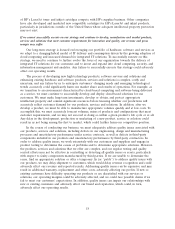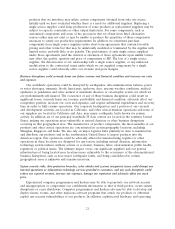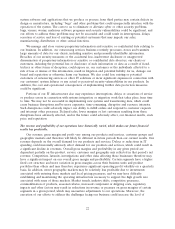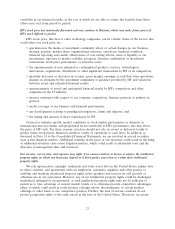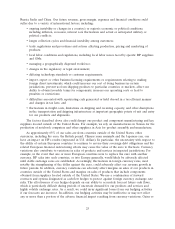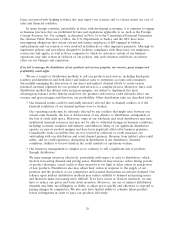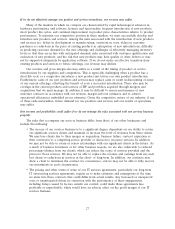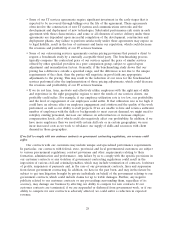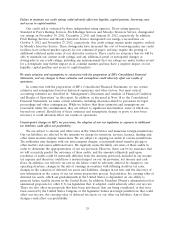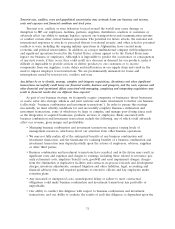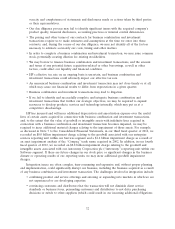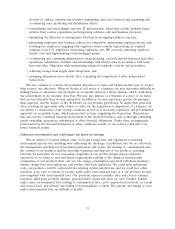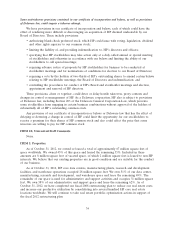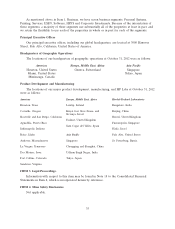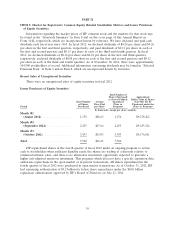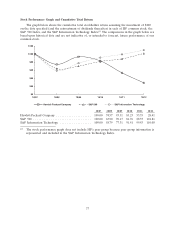HP 2012 Annual Report Download - page 35
Download and view the complete annual report
Please find page 35 of the 2012 HP annual report below. You can navigate through the pages in the report by either clicking on the pages listed below, or by using the keyword search tool below to find specific information within the annual report.If we do not effectively manage our product and services transitions, our revenue may suffer.
Many of the markets in which we compete are characterized by rapid technological advances in
hardware performance and software features and functionality, frequent introduction of new products,
short product life cycles, and continual improvement in product price characteristics relative to product
performance. To maintain our competitive position in these markets, we must successfully develop and
introduce new products and services. Among the risks associated with the introduction of new products
and services are: delays in development or manufacturing, variations in costs, delays in customer
purchases or reductions in the price of existing products in anticipation of new introductions, difficulty
in predicting customer demand for the new offerings and challenges of effectively managing inventory
levels so that they are in line with anticipated demand; risks associated with customer qualification and
evaluation of new products; and the risk that new products may have quality or other defects or may
not be supported adequately by application software. If we do not make an effective transition from
existing products and services to future offerings, our revenue may decline.
Our revenue and gross margin also may suffer as a result of the timing of product or service
introductions by our suppliers and competitors. This is especially challenging when a product has a
short life cycle or a competitor introduces a new product just before our own product introduction.
Furthermore, sales of our new products and services may replace sales or result in discounting of some
of our current offerings, offsetting the benefit of even a successful introduction. There also may be
overlaps in the current products and services of HP and portfolios acquired through mergers and
acquisitions that we must manage. In addition, it may be difficult to ensure performance of new
customer contracts in accordance with our revenue, margin and cost estimates and to achieve
operational efficiencies embedded in our estimates. Given the competitive nature of our industry, if any
of these risks materializes, future demand for our products and services and our results of operations
may suffer.
Our revenue and profitability could suffer if we do not manage the risks associated with our services business
properly.
The risks that accompany our services business differ from those of our other businesses and
include the following:
• The success of our services business is to a significant degree dependent on our ability to retain
our significant services clients and maintain or increase the level of revenues from these clients.
We may lose clients due to their merger or acquisition, business failure, contract expiration or
their conversion to a competing service provider or decision to in-source services. In addition,
we may not be able to retain or renew relationships with our significant clients in the future. As
a result of business downturns or for other business reasons, we are also vulnerable to reduced
processing volumes from our clients, which can reduce the scope of services provided and the
prices for those services. We may not be able to replace the revenue and earnings from any such
lost clients or reductions in services in the short- or long-term. In addition, our contracts may
allow a client to terminate the contract for convenience, and we may not be able to fully recover
our investments in such circumstances.
• The pricing and other terms of some of our IT services agreements, particularly our long-term
IT outsourcing services agreements, require us to make estimates and assumptions at the time
we enter into these contracts that could differ from actual results. Any increased or unexpected
costs or unanticipated delays in connection with the performance of these engagements,
including delays caused by factors outside our control, could make these agreements less
profitable or unprofitable, which would have an adverse affect on the profit margin of our IT
services business.
27



